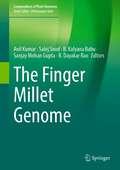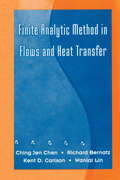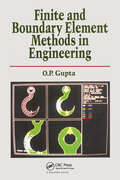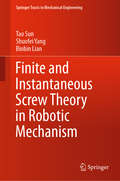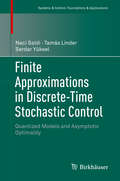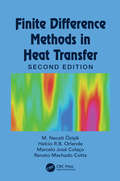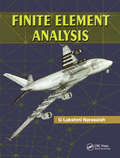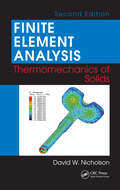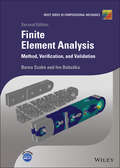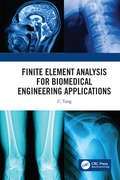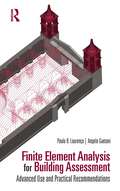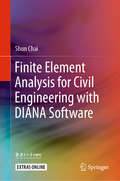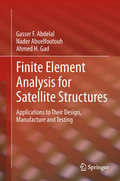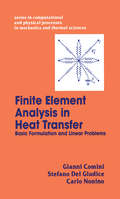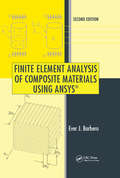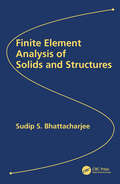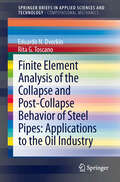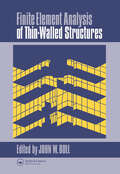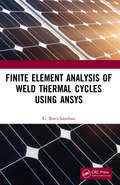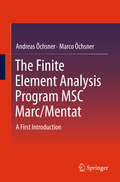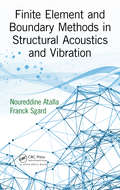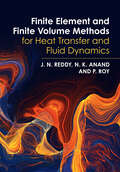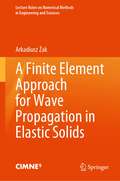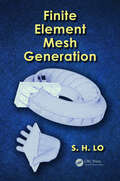- Table View
- List View
The Finger Millet Genome (Compendium of Plant Genomes)
by Anil Kumar Salej Sood B. Kalyana Babu Sanjay Mohan Gupta B. Dayakar RaoThis book is the first comprehensive compilation of deliberations on domestication, genetic and genomic resources, breeding, genetic diversity, molecular maps & mapping of important biotic stress as well as nutritional quality traits, genome sequencing, comparative genomics, functional genomics and genetic transformation. The economic, nutritional and health benefits especially antioxidants mediated antiaging effects of finger millet are also discussed. It also presents the input use efficiency, wide adaptation, post-harvest processing and value addition of the crop. Altogether, the book contains about 300 pages over 16 chapters authored by globally reputed experts on the relevant field in this crop. This book is useful to the students, teachers and scientists in the academia and relevant private companies interested in genetics, pathology, molecular genetics and breeding, genetic engineering, structural and functional genomics and nutritional quality aspects of the crop. This book is also useful to seed and pharmaceutical industries.
Fingerprinting Techniques in Food Authentication and Traceability (Food Analysis & Properties)
by K. S. Siddiqi Leo M.L. NolletThere is an increasing interest by consumers for high-quality food products with a clear geographical origin. With these products in demand, suitable analytical techniques are needed for the quality control. Current analytical approaches are mass spectrometry techniques, spectroscopic techniques, separation techniques, and others. Fingerprinting Techniques in Food Authentication and Traceability discusses the principles of the techniques together with their advantages and drawbacks, and reported applications concerning geographical authenticity. A combination of methods analyzing different types of food compounds seems to be the most promising approach to establish the geographical origin. The abundant acquired data are analyzed by chemometrics. Producing safe and high-quality food is a prerequisite to ensure consumer health and successful domestic and international trade, and is critical to the sustainable development of national agricultural resources. Systems to trace food or feed products through specified stages of production, processing, and distribution play a key role in assuring food safety. Analytical techniques that enable the provenance of food to be determined provide an independent means of verifying traceability systems and also help to prove product authenticity, to combat fraudulent practices and to control adulteration, which are important issues for economic, religious, or cultural reasons. Proof of provenance has become an important topic in the context of food safety, food quality, and consumer protection in accordance with national legislation and international standards and guidelines.
Finite Analytic Method in Flows and Heat Transfer
by R. A. BernatzThis book contains the fundamental development of the finite analytic method and gives a systematic coverage of knowledge needed for numerical computation of fluid flows and heat transfer. It will be helpful to many including graduate students studying computational fluid dynamics and heat transfer.
Finite and Boundary Element Methods in Engineering
by O.P. GuptaThe interest in finite element method as a solution technique of the computer age is reflected in the availability of many general and special purpose software based on this technique. This work aims to provide a complete and detailed explanation of the basics of the application areas.
Finite and Instantaneous Screw Theory in Robotic Mechanism (Springer Tracts in Mechanical Engineering)
by Tao Sun Shuofei Yang Binbin LianThis book presents a finite and instantaneous screw theory for the development of robotic mechanisms. It addresses the analytical description and algebraic computation of finite motion, resulting in a generalized type synthesis approach. It then discusses the direct connection between topology and performance models, leading to an integrated performance analysis and design framework. The book then explores parameter uncertainty and multiple performance requirements for reliable, optimal design methods, and describes the error accumulation principle and parameter identification algorithm, to increase robot accuracy. It proposes a unified and generic methodology, and appliesto the invention, analysis, design, and calibration of robotic mechanisms.The book is intended for researchers, graduate students and engineers in the fields of robotic mechanism and robot design and applications.
Finite Approximations in Discrete-Time Stochastic Control: Quantized Models And Asymptotic Optimality (Systems And Control: Foundations And Applications Ser.)
by Serdar Yüksel Tamás Linder Naci SaldiIn a unified form, this monograph presents fundamental results on the approximation of centralized and decentralized stochastic control problems, with uncountable state, measurement, and action spaces. It demonstrates how quantization provides a system-independent and constructive method for the reduction of a system with Borel spaces to one with finite state, measurement, and action spaces. In addition to this constructive view, the book considers both the information transmission approach for discretization of actions, and the computational approach for discretization of states and actions. Part I of the text discusses Markov decision processes and their finite-state or finite-action approximations, while Part II builds from there to finite approximations in decentralized stochastic control problems. This volume is perfect for researchers and graduate students interested in stochastic controls. With the tools presented, readers will be able to establish the convergence of approximation models to original models and the methods are general enough that researchers can build corresponding approximation results, typically with no additional assumptions.
Finite Difference Methods in Heat Transfer (Heat Transfer)
by M. Necati Özişik Helcio R. Orlande Marcelo J. Colaço Renato M. CottaFinite Difference Methods in Heat Transfer, Second Edition focuses on finite difference methods and their application to the solution of heat transfer problems. Such methods are based on the discretization of governing equations, initial and boundary conditions, which then replace a continuous partial differential problem by a system of algebraic equations. Finite difference methods are a versatile tool for scientists and for engineers. This updated book serves university students taking graduate-level coursework in heat transfer, as well as being an important reference for researchers and engineering. Features Provides a self-contained approach in finite difference methods for students and professionals Covers the use of finite difference methods in convective, conductive, and radiative heat transfer Presents numerical solution techniques to elliptic, parabolic, and hyperbolic problems Includes hybrid analytical–numerical approaches
Finite Element Analysis
by Lakshmi NarasaihaThe finite element method has undergone a major paradigm shift from a detailed mathematical background for writing tailor-made computer programs to a user-based approach for applying available software to engineering analysis and design scenarios. This textbook begins with a concise overview of fluid mechanics, motivated by numerous engineering app
Finite Element Analysis: Thermomechanics of Solids, Second Edition
by David W. NicholsonExplore a Unified Treatment of the Finite Element MethodThe finite element method has matured to the point that it can accurately and reliably be used, by a careful analyst, for an amazingly wide range of applications. With expanded coverage and an increase in fully solved examples, the second edition of Finite Element Analysis: Thermomechan
Finite Element Analysis: Method, Verification and Validation (Wiley Series in Computational Mechanics)
by Barna Szabó Ivo BabuškaFinite Element Analysis An updated and comprehensive review of the theoretical foundation of the finite element method The revised and updated second edition of Finite Element Analysis: Method, Verification, and Validation offers a comprehensive review of the theoretical foundations of the finite element method and highlights the fundamentals of solution verification, validation, and uncertainty quantification. Written by noted experts on the topic, the book covers the theoretical fundamentals as well as the algorithmic structure of the finite element method. The text contains numerous examples and helpful exercises that clearly illustrate the techniques and procedures needed for accurate estimation of the quantities of interest. In addition, the authors describe the technical requirements for the formulation and application of design rules. Designed as an accessible resource, the book has a companion website that contains a solutions manual, PowerPoint slides for instructors, and a link to finite element software. This important text: Offers a comprehensive review of the theoretical foundations of the finite element method Puts the focus on the fundamentals of solution verification, validation, and uncertainty quantification Presents the techniques and procedures of quality assurance in numerical solutions of mathematical problems Contains numerous examples and exercises Written for students in mechanical and civil engineering, analysts seeking professional certification, and applied mathematicians, Finite Element Analysis: Method, Verification, and Validation, Second Edition includes the tools, concepts, techniques, and procedures that help with an understanding of finite element analysis.
Finite Element Analysis for Biomedical Engineering Applications
by Z. C. YangFinite element analysis has been widely applied to study biomedical problems. This book aims to simulate some common medical problems using finite element advanced technologies, which establish a base for medical researchers to conduct further investigations. This book consists of four main parts: (1) bone, (2) soft tissues, (3) joints, and (4) implants. Each part starts with the structure and function of the biology and then follows the corresponding finite element advanced features, such as anisotropic nonlinear material, multidimensional interpolation, XFEM, fiber enhancement, UserHyper, porous media, wear, and crack growth fatigue analysis. The final section presents some specific biomedical problems, such as abdominal aortic aneurysm, intervertebral disc, head impact, knee contact, and SMA cardiovascular stent. All modeling files are attached in the appendixes of the book. This book will be helpful to graduate students and researchers in the biomedical field who engage in simulations of biomedical problems. The book also provides all readers with a better understanding of current advanced finite element technologies. Details finite element modeling of bone, soft tissues, joints, and implants Presents advanced finite element technologies, such as fiber enhancement, porous media, wear, and crack growth fatigue analysis Discusses specific biomedical problems, such as abdominal aortic aneurysm, intervertebral disc, head impact, knee contact, and SMA cardiovascular stent Explains principles for modeling biology Provides various descriptive modeling files
Finite Element Analysis for Building Assessment: Advanced Use and Practical Recommendations (Assessment, Repair and Strengthening for the Conservation of Structures)
by Paulo B. Lourenço Angelo GaetaniExisting structures represent a heterogeneous category in the global built environment as often characterized by the presence of archaic materials, damage and disconnections, uncommon construction techniques and subsequent interventions throughout the building history. In this scenario, the common linear elastic analysis approach adopted for new buildings is incapable of an accurate estimation of structural capacity, leading to overconservative results, invasive structural strengthening, added intervention costs, excessive interference to building users and possible losses in terms of aesthetics or heritage values. For a rational and sustainable use of the resources, this book deals with advanced numerical simulations, adopting a practical approach to introduce the fundamentals of Finite Element Method, nonlinear solution procedures and constitutive material models. Recommended material properties for masonry, timber, reinforced concrete, iron and steel are discussed according to experimental evidence, building standards and codes of practice. The examples examined throughout the book and in the conclusive chapter support the analyst’s decision-making process toward a safe and efficient use of finite element analysis. Written primarily for practicing engineers, the book is of value to students in engineering and technical architecture with solid knowledge in the field of continuum mechanics and structural design.
Finite Element Analysis for Civil Engineering with DIANA Software
by Shun ChaiThis book systematically introduces readers to the finite element analysis software DIANA (DIsplacement ANAlyzer) and its applications in civil engineering. Developed by TNO Corporation in the 1970s, DIANA is frequently used in civil engineering and engineering mechanics. Unlike the software user’s manual, which provides a comprehensive introduction and theoretical analysis, this book presents a simplified overview of the basic background theory to help beginners master the software quickly. It also discusses GUI operation and the command console in Python language, and includes examples involving classical modeling operations to help readers review each section. Both the book and DIANA itself are valuable resources for students and researchers in all the structural engineering fields, such as civil engineering, bridge engineering, geotechnical engineering, tunnel engineering, underground structural engineering, irrigation, municipal engineering and fire engineering.
Finite Element Analysis for Satellite Structures
by Nader Abuelfoutouh Gasser F. Abdelal Ahmed H. GadDesigning satellite structures poses an ongoing challenge as the interaction between analysis, experimental testing, and manufacturing phases is underdeveloped. Finite Element Analysis for Satellite Structures: Applications to Their Design, Manufacture and Testing explains the theoretical and practical knowledge needed to perform design of satellite structures. By layering detailed practical discussions with fully developed examples, Finite Element Analysis for Satellite Structures: Applications to Their Design, Manufacture and Testing provides the missing link between theory and implementation. Computational examples cover all the major aspects of advanced analysis; including modal analysis, harmonic analysis, mechanical and thermal fatigue analysis using finite element method. Test cases are included to support explanations an a range of different manufacturing simulation techniques are described from riveting to shot peening to material cutting. Mechanical design of a satellites structures are covered in three steps: analysis step under design loads, experimental testing to verify design, and manufacturing. Stress engineers, lecturers, researchers and students will find Finite Element Analysis for Satellite Structures: Applications to Their Design, Manufacture and Testing a key guide on with practical instruction on applying manufacturing simulations to improve their design and reduce project cost, how to prepare static and dynamic test specifications, and how to use finite element method to investigate in more details any component that may fail during testing.
Finite Element Analysis In Heat Transfer: Basic Formulation & Linear Problems (Computational and Physical Processes in Mechanics and Thermal Sciences)
by Gianni CominiThis introductory text presents the applications of the finite element method to the analysis of conduction and convection problems. The book is divided into seven chapters which include basic ideas, application of these ideas to relevant problems, and development of solutions. Important concepts are illustrated with examples. Computer problems are also included to facilitate the types of solutions discussed.
Finite Element Analysis of Composite Materials Using ANSYS
by Ever J. BarberoDesigning structures using composite materials poses unique challenges, especially due to the need for concurrent design of both material and structure. Students are faced with two options: textbooks that teach the theory of advanced mechanics of composites, but lack computational examples of advanced analysis, and books on finite element analysis
Finite Element Analysis of Solids and Structures
by Sudip S. BhattacharjeeFinite Element Analysis of Solids and Structures combines the theory of elasticity (advanced analytical treatment of stress analysis problems) and finite element methods (numerical details of finite element formulations) into one academic course derived from the author’s teaching, research, and applied work in automotive product development as well as in civil structural analysis. Features Gives equal weight to the theoretical details and FEA software use for problem solution by using finite element software packages Emphasizes understanding the deformation behavior of finite elements that directly affect the quality of actual analysis results Reduces the focus on hand calculation of property matrices, thus freeing up time to do more software experimentation with different FEA formulations Includes chapters dedicated to showing the use of FEA models in engineering assessment for strength, fatigue, and structural vibration properties Features an easy to follow format for guided learning and practice problems to be solved by using FEA software package, and with hand calculations for model validation This textbook contains 12 discrete chapters that can be covered in a single semester university graduate course on finite element analysis methods. It also serves as a reference for practicing engineers working on design assessment and analysis of solids and structures. Teaching ancillaries include a solutions manual (with data files) and lecture slides for adopting professors.
Finite Element Analysis of the Collapse and Post-Collapse Behavior of Steel Pipes: Applications to the Oil Industry
by Eduardo N Dvorkin Rita G. ToscanoThis book presents a detailed discussion of the models that were developed to simulate the collapse and post-collapse behavior of steel pipes. The finite element method offers to engineers the possibility of developing models to simulate the collapse behavior of casings inside oil wells and the collapse behavior of deepwater pipelines. However, if technological decisions are going to be reached from these model results, with implications for the economic success of industrial operations, for the occupational safety and health and for the environment, the engineering models need to be highly reliable. Using these models engineers can quantify the effect of manufacturing tolerances, wear, corrosion, etc. This book describes in great details the experimental programs that are developed to validate the numerical results.
Finite Element Analysis of Thin-Walled Structures
by John W. BullThis book describes current developments in finite element analysis and the design of certain types of thin-walled structures. The first three chapters lay the foundations for the development and use of finite elements for thin-walled structures, look at finite elements packages and discuss data input and mesh arrangements. The final four chapters use the finite element method to assist in the solution of thin-walled structure problems. Some of the problems solved include; water and air inflated structures; axisymmetric thin shells; ship structures and offshore structures. This book will be an interest to design engineers, researchers and postgraduates.
Finite Element Analysis of Weld Thermal Cycles Using ANSYS
by G. RavichandranFinite Element Analysis of Weld Thermal Cycles Using ANSYS aims at educating a young researcher on the transient analysis of welding thermal cycles using ANSYS. It essentially deals with the methods of calculation of the arc heat in a welded component when the analysis is simplified into either a cross sectional analysis or an in-plane analysis. The book covers five different cases involving different welding processes, component geometry, size of the element and dissimilar material properties. A detailed step by step calculation is presented followed by APDL program listing and output charts from ANSYS. Features: Provides useful background information on welding processes, thermal cycles and finite element method Presents calculation procedure for determining the arc heat input in a cross sectional analysis and an in-plane analysis Enables visualization of the arc heat in a FEM model for various positions of the arc Discusses analysis of advanced cases like dissimilar welding and circumferential welding Includes step by step procedure for running the analysis with typical input APDL program listing and output charts from ANSYS.
The Finite Element Analysis Program MSC Marc/Mentat
by Andreas Öchsner Marco ÖchsnerBased on simple examples, this book offers a short introduction to the general-purpose finite element program MSC Marc, a specialized program for non-linear problems (implicit solver) distributed by the MSC Software Corporation, which is commonly used in academia and industry. Today the documentation of all finite element programs includes a variety of step-by-step examples of differing complexity, and in addition, all software companies offer professional workshops on different topics. As such, rather than competing with these, the book focuses on providing simple examples, often single-element problems, which can easily be related to the theory that is discussed in finite element lectures. This makes it an ideal companion book to classical introductory courses on the finite element method.
Finite Element and Boundary Methods in Structural Acoustics and Vibration
by Noureddine Atalla Franck SgardEffectively Construct Integral Formulations Suitable for Numerical ImplementationFinite Element and Boundary Methods in Structural Acoustics and Vibration provides a unique and in-depth presentation of the finite element method (FEM) and the boundary element method (BEM) in structural acoustics and vibrations. It illustrates the principles using a
Finite Element and Finite Volume Methods for Heat Transfer and Fluid Dynamics
by J. N. Reddy N. K. Anand P. RoyIntroduces the two most common numerical methods for heat transfer and fluid dynamics equations, using clear and accessible language. This unique approach covers all necessary mathematical preliminaries at the beginning of the book for the reader to sail smoothly through the chapters. Students will work step-by-step through the most common benchmark heat transfer and fluid dynamics problems, firmly grounding themselves in how the governing equations are discretized, how boundary conditions are imposed, and how the resulting algebraic equations are solved. Providing a detailed discussion of the discretization steps and time approximations, and clearly presenting concepts of explicit and implicit formulations, this graduate textbook has everything an instructor needs to prepare students for their exams and future careers. Each illustrative example shows students how to draw comparisons between the results obtained using the two numerical methods, and at the end of each chapter they can test and extend their understanding by working through the problems provided. A solutions manual is also available for instructors.
A Finite Element Approach for Wave Propagation in Elastic Solids (Lecture Notes on Numerical Methods in Engineering and Sciences)
by Arkadiusz ŻakThis book focuses on wave propagation phenomena in elastic solids modelled by the use of the finite element method. Although the latter is a well-established and popular numerical tool used by engineers and researchers all around the word the process of modelling of wave propagation can still be a challenge. The book introduces a reader to the problem by presenting a historical background and offering a broad perspective on the development of modern science and numerical methods. The principles of wave phenomena are clearly presented to the reader as well as the necessary background for understanding the finite element method, which is the following chapter of the book is viewed from the modeller point-of-view. Apart from the principles the book also addresses more advanced topics and problems including the use of the spectral-finite element method, the spline-based finite element method as well as the problems of undesired and hidden properties of discrete numerical models.
Finite Element Mesh Generation
by Daniel S.H. LoHighlights the Progression of Meshing Technologies and Their ApplicationsFinite Element Mesh Generation provides a concise and comprehensive guide to the application of finite element mesh generation over 2D domains, curved surfaces, and 3D space. Organised according to the geometry and dimension of the problem domains, it develops from the basic m
